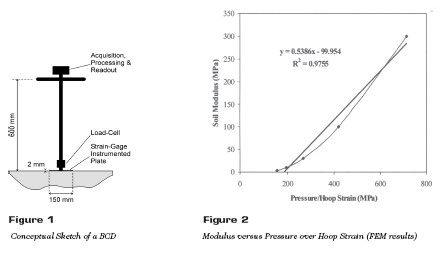|
NCHRP IDEA 20-30/IDEA 118 [Completed (IDEA)]
The BCD: A New Instrument for Compaction Control
[ NCHRP 20-30 (NCHRP-IDEA) ]
| Project Data |
| Staff Responsibility: |
Dr. Inam Jawed |
|
This project developed and evaluated a portable equipment (Briaud Compaction Device - BCD) for measuring the soil modulus for compaction control in the field and establishing a target value in the laboratory (Figure 1). The device consists of a thin steel plate, 150 mm (6 inches) in diameter, at the bottom of a rod. As the operator leans on the rod handle, the plate bends and the strain produced in the plate is recorded. Work in the initial phase focused on further improvements to the design of the BCD equipment and laboratory testing in collaboration with Roctest, a commercial manufacturer based in Canada. Use of a wet sand cushion between the plate and the soil significantly reduced the effect of an uneven surface and minimized variation in field test readings. Numerical simulations estimated the modulus range of the BCD between 3 MPa and 300 MPa (30 to 3000 tsf) (Figure 2) and the depth of influence of about 150 mm (6 inches) for a soil modulus in the 5 MPa and 100 MPa range (50 to 1000 tsf). Tests using a rubber block showed a linear relationship between the load applied on the BCD and the hoop strain recorded on the steel plate. Repeated testing on the same block showed very good repeatability of the test. Plate tests, performed in parallel with the BCD tests, showed good correlation between the plate and the BCD modulii. In the laboratory, the BCD test was performed on top of the Proctor mold allowing one to obtain curves of the modulus and dry density against water content and also helping choose a target value for the specifications. A universal joint on the plate was added at the bottom of the rod to prevent the influence of parasite moments generated by the operator. Stoppers were also added to prevent the plate from deforming beyond its operating range. The diameter of the rod connecting to the plate was reduced to 25 mm (1 inch) to extend the range of the BCD to harder soils. A water and dust proof silicon coating was applied to the BCD plate and a rubber bell was placed above the plate to protect the strain gages against harsh field conditions. A calibration procedure was developed using calibrated rubber blocks of known modulii; this allowed each BCD unit to be calibrated independently of the manufacturing variabilities. Resilient modulus tests and parallel BCD tests were performed in the laboratory on silty clay samples, 150 mm (6 inches) in diameter and 200 mm (8 inches) high, at various water contents. The data show a good correlation between the resilient modulus and the BCD modulus for different water contents for a given soil.

|
|